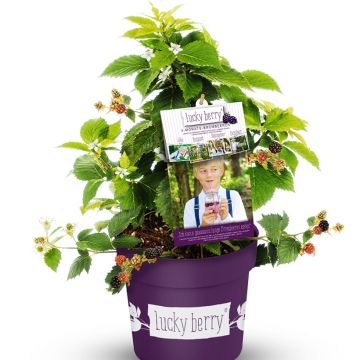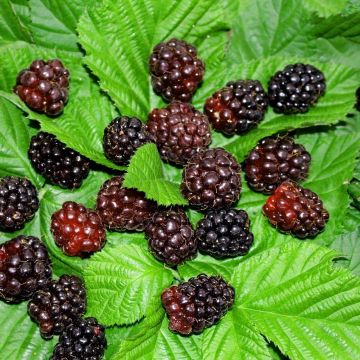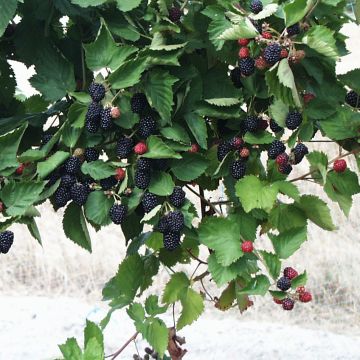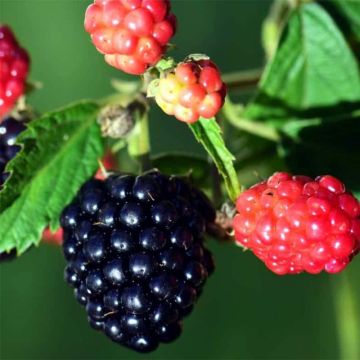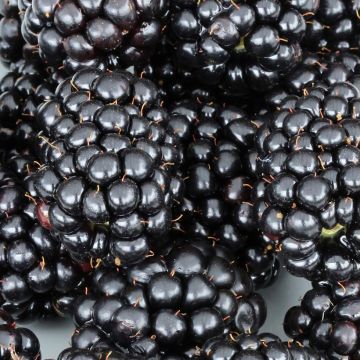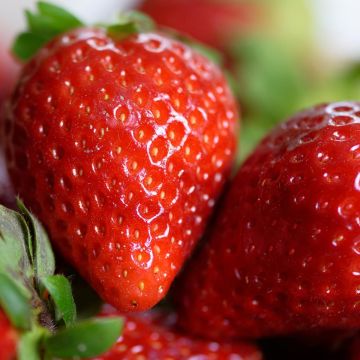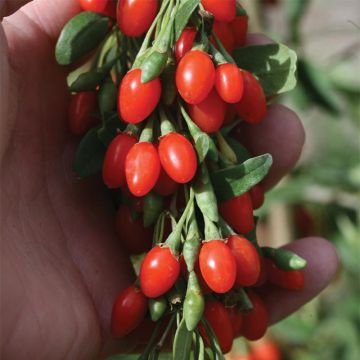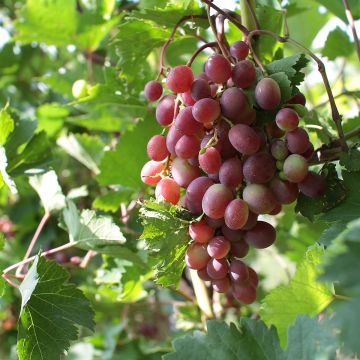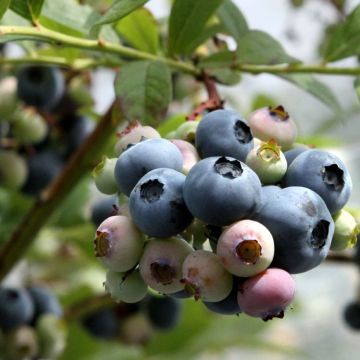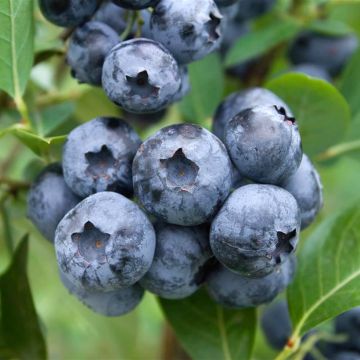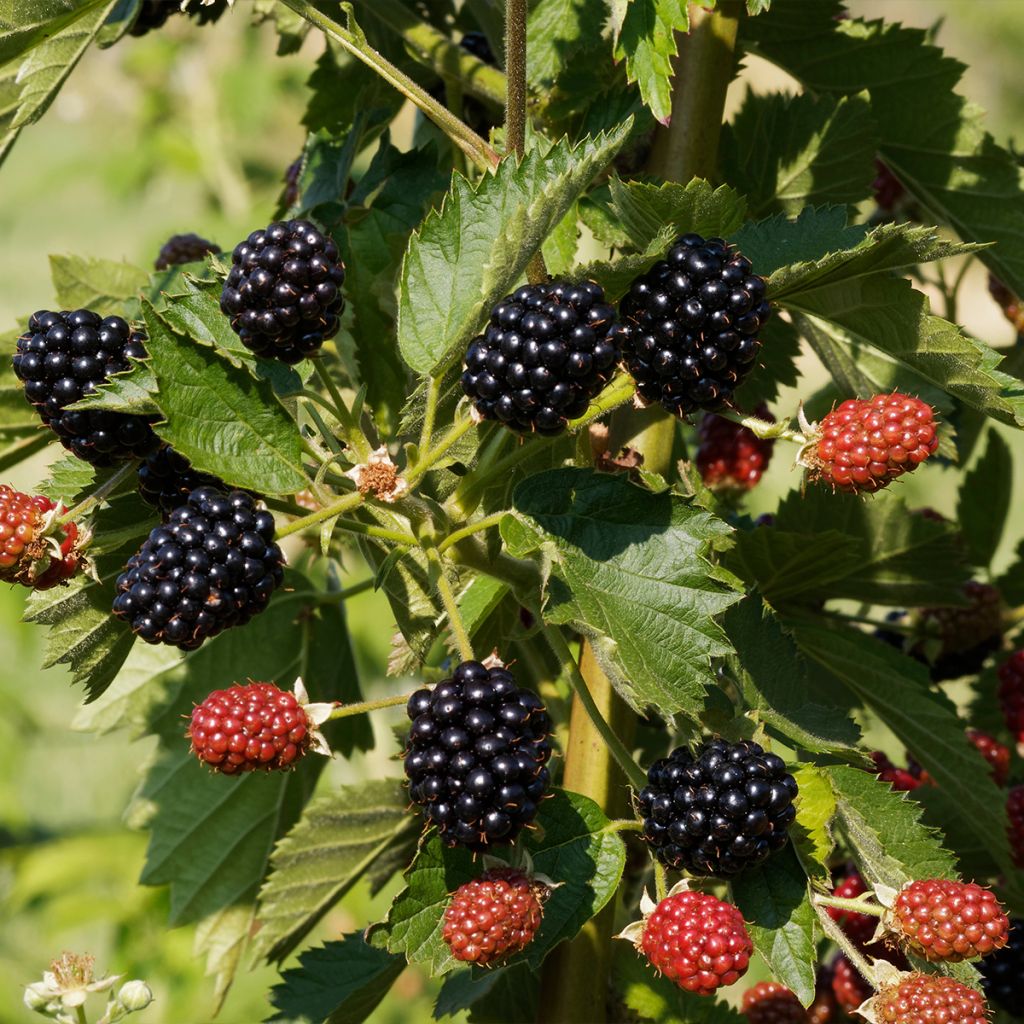

Thornless Blackberry Oregon Thornless - Rubus fruticosus
Thornless Blackberry Oregon Thornless - Rubus fruticosus
Rubus fruticosus Oregon Thornless
Blackberry, Bramble
For now they're growing very well, and the first fruits are appearing!
Carmi, 16/06/2025
Special offer!
Receive a €20 voucher for any order over €90 (excluding delivery costs, credit notes, and plastic-free options)!
1- Add your favorite plants to your cart.
2- Once you have reached €90, confirm your order (you can even choose the delivery date!).
3- As soon as your order is shipped, you will receive an email containing your voucher code, valid for 3 months (90 days).
Your voucher is unique and can only be used once, for any order with a minimum value of €20, excluding delivery costs.
Can be combined with other current offers, non-divisible and non-refundable.
Home or relay delivery (depending on size and destination)
Schedule delivery date,
and select date in basket
This plant carries a 6 months recovery warranty
More information
We guarantee the quality of our plants for a full growing cycle, and will replace at our expense any plant that fails to recover under normal climatic and planting conditions.
Description
The Oregon Thornless Blackberry, also known as Rubus fruticosus or Blackberry Bramble, shows rapid growth and produces an abundance of large, delicious and sweet black fruits. It is a particularly vigorous and productive, hardy variety that should be trained along a wall or on a sturdy trellis. It is a self-fertile variety that yields a bountiful harvest in September and October. The fruits are great for making jams, jellies or pies. As a bonus, this Blackberry Bramble is thornless and its highly dissected foliage is particularly ornamental. It can be planted in ordinary, not too dry to moist soil, in full sun or partial shade.
Rubus fruticosus Oregon Thornless belongs to the large and important Rosaceae family, which gives us so many ornamental species (Roses of course, but also Photinia, Cotoneaster, Amelanchier...) as well as most of our temperate climate fruits (Pear, Apple, Cherry, Peach, Apricot, Plum...). The genus Rubus itself is extremely diverse, with probably a thousand species worldwide. Some are ornamental, with decorative or aesthetically pleasing flowers or white shoots, as in Rubus thibetanus. Others have culinary value, such as raspberries (Rubus idaeus) and blackberries (Rubus fruticosus).
"Oregon Thornless" is ornamental and produces of delicious fruits... a double delight for the garden! It is a perennial climbing plant that reaches maturity in two years, reaching about 2m (7ft) high or more with a width of 1.5 to 2m (5 to 7ft). The fairly dark green foliage is semi-evergreen in winter and composed of highly dissected and even jagged and toothed leaves, with visible veins. This unique foliage has real ornamental value, especially as it turns dark red in cold climates in autumn before eventually falling. The stems are thornless and only live until they bear fruit (2 years), being replaced gradually by suckers emerging from the base. Each year, the stems that have borne fruit should be pruned back to two buds. The abundant and nectar-rich flowering consists of numerous small white, 1.5 to 2cm (1in) diameter flowers, grouped in clusters in June and July. The subsequent fruits are formed by drupes clustered on the receptacle. They are large and turn from red to black when ripe, in September and October. They should be picked when fully black, as they are then sweet and slightly tart, and can be eaten fresh, frozen, used in pies or made into jam.
Oregon Thornless Blackberry with its jagged leaves is to blackberries what Chasselas Cioutat, a mutation of Chasselas with parsley-like foliage, is to grapes. It is an ornamental and edible plant that delights the senses. For variety, plant it alongside grapes, such as the Fragola Bianca Grape Vine, a variety that produces seedless white-pink berries with a surprising aroma similar to wild strawberries. The Vitikiwi Kiwai, or Actinidia arguta, with its small and sweet fruits in the same season will also delight your taste buds.
Report an error about the product description
Thornless Blackberry Oregon Thornless - Rubus fruticosus in pictures
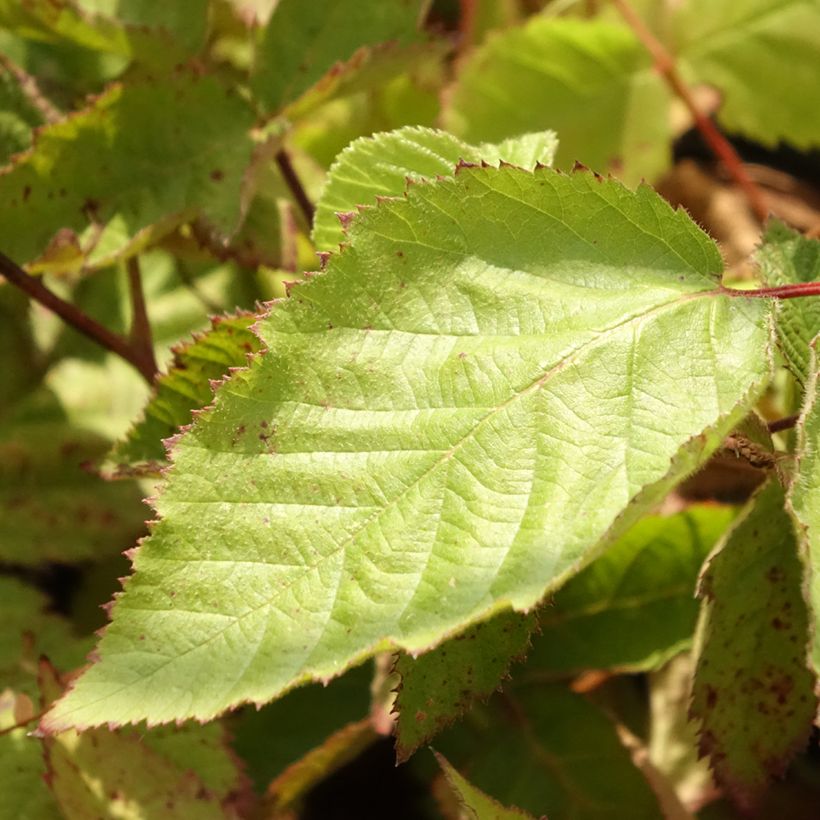

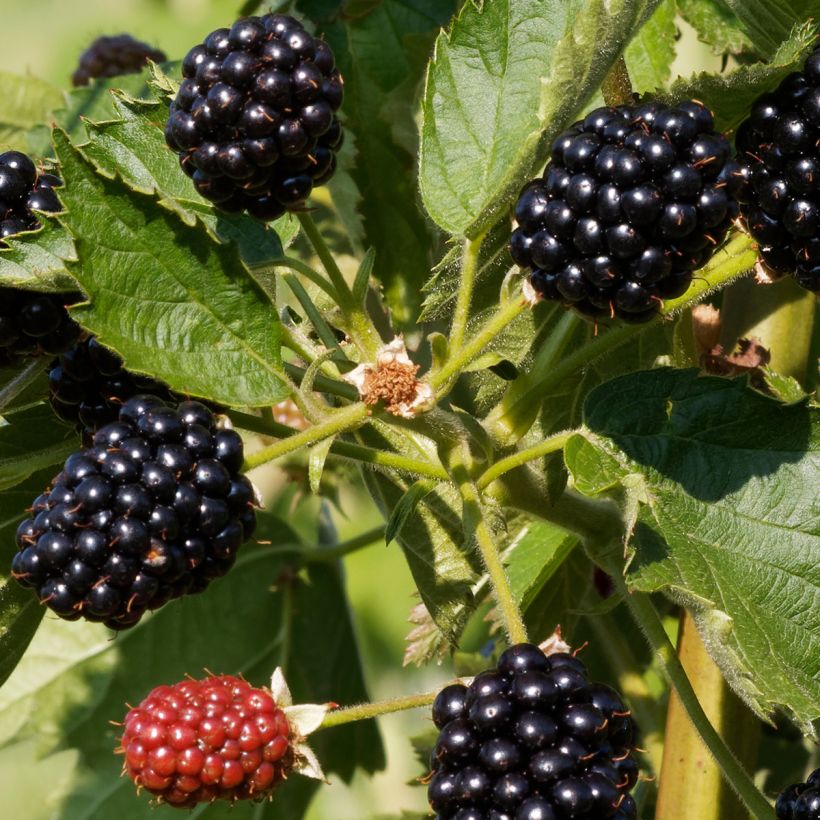

Plant habit
Fruit
Flowering
Foliage
Botanical data
Rubus
fruticosus
Oregon Thornless
Rosaceae
Blackberry, Bramble
Cultivar or hybrid
Other Blackberry bush
View all →Planting and care
The Oregon Thornless Blackberry prefers deep, fertile, not too dry to moist soil, but it is a low-maintenance plant that will adapt to any ordinary soil that is not too dry. This blackberry bush bears fruit in the sun, in partial shade, or even in shade, where the fruits will be of lower quality. Pot-grown plants can be planted at any time of the year. However, it is best to plant it in the garden in autumn, from September to November, unless you live in a region with very cold winters, in which case you should plant it in March. Dig a hole much larger than the root system. Loosen the root ball with a slightly sharp tool to loosen the tangle of roots and promote growth. Place the bush in the hole without burying it too deeply. Water thoroughly to compact the soil and remove air around the roots. It is important to ensure that the plant does not lack water during the first year after planting. Adding organic fertiliser at the beginning of the growing season is beneficial. Train the new shoots as they grow.
Planting period
Intended location
Care
-
, onOrder confirmed
Reply from on Promesse de fleurs
Similar products
Haven't found what you were looking for?
Hardiness is the lowest winter temperature a plant can endure without suffering serious damage or even dying. However, hardiness is affected by location (a sheltered area, such as a patio), protection (winter cover) and soil type (hardiness is improved by well-drained soil).

Photo Sharing Terms & Conditions
In order to encourage gardeners to interact and share their experiences, Promesse de fleurs offers various media enabling content to be uploaded onto its Site - in particular via the ‘Photo sharing’ module.
The User agrees to refrain from:
- Posting any content that is illegal, prejudicial, insulting, racist, inciteful to hatred, revisionist, contrary to public decency, that infringes on privacy or on the privacy rights of third parties, in particular the publicity rights of persons and goods, intellectual property rights, or the right to privacy.
- Submitting content on behalf of a third party;
- Impersonate the identity of a third party and/or publish any personal information about a third party;
In general, the User undertakes to refrain from any unethical behaviour.
All Content (in particular text, comments, files, images, photos, videos, creative works, etc.), which may be subject to property or intellectual property rights, image or other private rights, shall remain the property of the User, subject to the limited rights granted by the terms of the licence granted by Promesse de fleurs as stated below. Users are at liberty to publish or not to publish such Content on the Site, notably via the ‘Photo Sharing’ facility, and accept that this Content shall be made public and freely accessible, notably on the Internet.
Users further acknowledge, undertake to have ,and guarantee that they hold all necessary rights and permissions to publish such material on the Site, in particular with regard to the legislation in force pertaining to any privacy, property, intellectual property, image, or contractual rights, or rights of any other nature. By publishing such Content on the Site, Users acknowledge accepting full liability as publishers of the Content within the meaning of the law, and grant Promesse de fleurs, free of charge, an inclusive, worldwide licence for the said Content for the entire duration of its publication, including all reproduction, representation, up/downloading, displaying, performing, transmission, and storage rights.
Users also grant permission for their name to be linked to the Content and accept that this link may not always be made available.
By engaging in posting material, Users consent to their Content becoming automatically accessible on the Internet, in particular on other sites and/or blogs and/or web pages of the Promesse de fleurs site, including in particular social pages and the Promesse de fleurs catalogue.
Users may secure the removal of entrusted content free of charge by issuing a simple request via our contact form.
The flowering period indicated on our website applies to countries and regions located in USDA zone 8 (France, the United Kingdom, Ireland, the Netherlands, etc.)
It will vary according to where you live:
- In zones 9 to 10 (Italy, Spain, Greece, etc.), flowering will occur about 2 to 4 weeks earlier.
- In zones 6 to 7 (Germany, Poland, Slovenia, and lower mountainous regions), flowering will be delayed by 2 to 3 weeks.
- In zone 5 (Central Europe, Scandinavia), blooming will be delayed by 3 to 5 weeks.
In temperate climates, pruning of spring-flowering shrubs (forsythia, spireas, etc.) should be done just after flowering.
Pruning of summer-flowering shrubs (Indian Lilac, Perovskia, etc.) can be done in winter or spring.
In cold regions as well as with frost-sensitive plants, avoid pruning too early when severe frosts may still occur.
The planting period indicated on our website applies to countries and regions located in USDA zone 8 (France, United Kingdom, Ireland, Netherlands).
It will vary according to where you live:
- In Mediterranean zones (Marseille, Madrid, Milan, etc.), autumn and winter are the best planting periods.
- In continental zones (Strasbourg, Munich, Vienna, etc.), delay planting by 2 to 3 weeks in spring and bring it forward by 2 to 4 weeks in autumn.
- In mountainous regions (the Alps, Pyrenees, Carpathians, etc.), it is best to plant in late spring (May-June) or late summer (August-September).
The harvesting period indicated on our website applies to countries and regions in USDA zone 8 (France, England, Ireland, the Netherlands).
In colder areas (Scandinavia, Poland, Austria...) fruit and vegetable harvests are likely to be delayed by 3-4 weeks.
In warmer areas (Italy, Spain, Greece, etc.), harvesting will probably take place earlier, depending on weather conditions.
The sowing periods indicated on our website apply to countries and regions within USDA Zone 8 (France, UK, Ireland, Netherlands).
In colder areas (Scandinavia, Poland, Austria...), delay any outdoor sowing by 3-4 weeks, or sow under glass.
In warmer climes (Italy, Spain, Greece, etc.), bring outdoor sowing forward by a few weeks.































